Перут и сува кожа код паса

Пси, баш као и људи, могу да пате од перути. Међутим, због количине длаке коју имају, перут може постати много иритантније стање за псе него што је то код нас случај. То чак може бити показатељ већег, скривеног стања.
Шта је перут код паса?
Перут се јавља код паса када почне прекомерно лучење лојних жлезда – оних које су одговорне за производњу уља која штите и негују кожу. Вишак уља може иритирати кожу и довести до перутања и осипања коже у већим количинама од уобичајене.
Који су симптоми перути код паса?
Приметићете да кожа вашег пса изгледа суво и можда надражено или упаљено. На крзну ће стајати беле тачкице које могу спадати на њихову простирку или на вашу одећу. У зависности од озбиљности перути и узрока, такође можете приметити красте, општи губитак длаке, неправилне флеке без длаке и нешто чешања или свраба.
Перут код паса се често појављује код штенаца с посебним ризиком код средњедлаких и дугодлаких раса.

Шта је узрок перути код мог пса?
Један од најчешћих узрока перути код паса је исхрана која не укључује потребне или најквалитетније хранљиве састојке који су вашем псу потребни за развијање здраве длаке и коже. Есенцијалне масне киселине, попут омега 3 и 6, пресудне су за подршку кожи вашег пса, а како их пси не могу сами синтетизовати, морају се налазити у њиховој исхрани.
Слично томе, протеин је веома важан. Кожа и длака вашег пса користе 30% дневног уноса протеина за раст и развој, тако да високо сварљиви и висококвалитетни извори протеина морају бити део онога што једу. Витамин А је такође кључан, јер помаже у регулисању раста ћелија коже и стварању себума.
Перут код паса такође може бити узрокована окружењем. Сезонско перутање је нормално за многе расе паса, али ако је њихов простор посебно топао или хладан, то може покренути реакције на њиховој кожи и прекинути производњу уља, што заузврат може довести до перути. На пример, посебно топло окружење може врло брзо да исуши кожу пса.
Перут такође може бити симптом паразитске заразе. Ваши које грицкају, ваши које сисају и гриње под називом шетајућа перут могу изазвати перут јер живе у крзну и иритирају кожу. Ово подстиче вашег пса да се чеше и да кожа реагује. Гриње типа ходајућа перут посебно узрокују опадање коже у виду љуспица, што доводи до свраба, перути, па чак и губитка длаке.
Како могу да решим проблем перути код свог пса?
Ако приметите да ваш пас има перут, свраб, да се чеше или друге проблеме са кожом, неопходно је да разговарате са ветеринаром. Иако је перут уобичајена, ваш ветеринар ће желети да искључи било који други проблем као што је атопијски дерматитис. Он ће обавити преглед и тестове и пружити вам прави третман за вашег љубимца, што је посебно важно у случају паразита.
Такође можете проактивно третирати перут код пса тако што ћете:
- Одржавати његово окружење на пријатној температури
- Давати храну која је богата хранљивим састојцима потребним за здраву кожу и длаку
- Користити одговарајуће специјалне шампоне – људски шампон није погодан, јер је наша кожа киселија, па чак и нежни производи могу исушити кожу вашег пса
- Разговарајте са ветеринаром о допуни исхране вашег пса уљем јетре бакалара или рибљим уљем ради побољшања здравља коже
Related Articles

Пронађите ветеринара
Ако имате било каквих недоумица у вези са здрављем свог пса, потражите стручни савет ветеринара.
Лајкуј и подели страницу